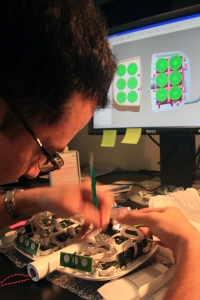
Using Agile as a Catalyst for Innovation in Product Development
BY DEVIN MOORE
Improving innovation content is essential to our business, as our clients expect ever more innovative solutions to rather complex problems.
A few years ago Big Bang began using Agile and Agile-like processes on our hardware programs that included digital interaction and GUIs. We have come to appreciate the user focused exercises and problem solving. In addition I am convinced that Agile processes can be a platform for innovation, essential as technology becomes integral to physical products and we are asked to deliver more and more inspiring product experiences.
Not intended as a platform for innovation, Agile has three common core principles I have found to be essential to the idea of sustainable and continuous innovation: collaboration, iteration, and adaptive development.
Agile principles were documented in 2001, outside of the hardware product development sphere, by a few software developers who got together and created the Agile Manifesto, an approach to developing software products that was an alternative to “documentation driven, heavyweight development processes,” in other words traditional Waterfall methodologies. The Agile process has since become mainstream for the development of software, and regular updates on our various digital devices have become a familiar manifestation of the practice.
The authors of the Agile Manifesto believed in collaboration, in “teams and interactions.” The required rigor of long-term and enduring innovation requires the constant and consistent nurturing and contribution of diverse points of view. These interactions take the form of stand up reviews, team brainstorming, and cross-functional collaborative problem solving.
 Iteration and innovation are proven allies, and the Agile principle “Deliver working software frequently” asserts the need for iteration to perfect a product for release. It is interesting to note the similarity to the premise of Design Thinking, to design/build/test/repeat. Design Thinking and Agile originated about the same time, and hints at some connection between what was happening in the product and software development communities. Iteration can formally be assured through proper Agile processes, for example the use of sprints with Scrum Methodology. At Big Bang we use a less formal approach, but more on that in a separate post.
Iteration and innovation are proven allies, and the Agile principle “Deliver working software frequently” asserts the need for iteration to perfect a product for release. It is interesting to note the similarity to the premise of Design Thinking, to design/build/test/repeat. Design Thinking and Agile originated about the same time, and hints at some connection between what was happening in the product and software development communities. Iteration can formally be assured through proper Agile processes, for example the use of sprints with Scrum Methodology. At Big Bang we use a less formal approach, but more on that in a separate post.
A flexible development methodology can be the most difficult part of innovative product development in the real world, but throughout history innovation success is typically a result of course correction, and sometimes failure. I believe the Agile authors incorporated “Responding to change over following a plan” in the manifesto because they understood how critical it is to adapt and act on insights gained through research or testing. “Change” in Agile is understood to be a “competitive advantage”. This is where good project management and trust in the development team are critical to project success. Pivots are difficult, but can be worthwhile if managed well.
Staying competitive means delivering exceptional product experiences that customers love, quickly.
With more product assignments coming with vague requirements, unclear product plans, and ambitious expectations, I find traditional Waterfall methods to be lacking. Consistent and sustainable innovation sounds like an oxymoron, akin to believing that lightning can strike the same place more than once, but Agile centered processes have proven to deliver compelling pioneering products.
Kaboom!
